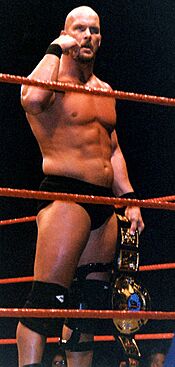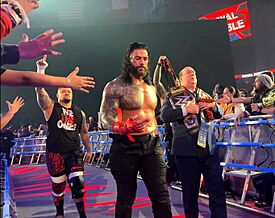WWE facts for kids
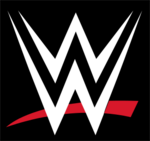 |
|
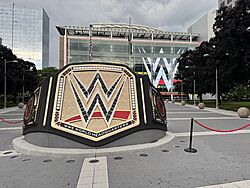
Headquarters in Stamford, Connecticut
|
|
|
Trade name
|
WWE |
|---|---|
|
Formerly
|
Titan Sports, Inc. (1980–1999) World Wrestling Federation Entertainment, Inc. (1999–2002) World Wrestling Entertainment, Inc. (2002–2023) |
| Subsidiary | |
| Industry |
|
| Predecessor | Capitol Wrestling Corporation Ltd. |
| Founded |
|
| Founder | Jess McMahon or Vincent J. McMahon (as Capitol Wrestling Corporation Ltd.) Vince McMahon and Linda McMahon (as Titan Sports, Inc.) |
| Headquarters |
707 Washington Blvd
,
Stamford, Connecticut United States
|
|
Area served
|
Worldwide |
|
Key people
|
|
| Products |
|
| Services | Licensing |
| Revenue | |
|
Operating income
|
|
|
Number of employees
|
~890 (2024) |
| Parent | TKO Group Holdings |
| Divisions | WWE Books WWE Libraries WWE Music Group WWE Network WWE Performance Center WWE Studios |
| Subsidiaries | Lucha Libre AAA Worldwide (51%) Tapout (50%) WCW Inc. Others |
World Wrestling Entertainment, LLC (WWE) is a big American company that puts on professional wrestling shows. It is part of TKO Group Holdings, which is mostly owned by Endeavor Group Holdings. WWE is a global entertainment company. It also creates movies through WWE Studios, and licenses its ideas for things like video games and action figures.
Professional wrestling, like what WWE does, is a form of entertainment. It's not a real sport where the outcome is unknown. Instead, it's like a play with exciting stories, scripted matches, and planned moves. Even though the matches are planned, the performers are very athletic and train hard. They perform moves that can be dangerous if not done correctly. WWE calls its product "sports entertainment" because it combines the excitement of sports with dramatic storytelling.
The company started in 1953 as the Capitol Wrestling Corporation (CWC). It was part of a larger wrestling group called the National Wrestling Alliance (NWA). In 1963, CWC left the NWA and became the World Wide Wrestling Federation (WWWF). Later, in 1979, it changed its name to the World Wrestling Federation (WWF). In 2002, the WWF changed its name again to World Wrestling Entertainment (WWE) due to a legal issue with the World Wildlife Fund. Since 2011, the company has mostly used just the initials WWE, even though its full legal name is World Wrestling Entertainment, LLC.
WWE is the biggest wrestling company in the world. Its main wrestlers are split into two groups called Raw and SmackDown. It also has training brands like NXT, where new wrestlers learn and develop their skills. WWE shows are available in over one billion homes around the world in 30 languages. Its main office is in Stamford, Connecticut, USA, with other offices in major cities worldwide.
The company that owns WWE, called Titan Sports, Inc., was started in 1980 by Vince McMahon and his wife Linda McMahon. Titan Sports bought the original wrestling company in 1982. Titan Sports later changed its name to World Wrestling Federation Entertainment, Inc. in 1999, and then to World Wrestling Entertainment, Inc. in 2002. In 2023, WWE joined with Zuffa, the company that owns Ultimate Fighting Championship (UFC), to create a new company called TKO Group Holdings. This made WWE's legal name World Wrestling Entertainment, LLC.
Contents
- WWE's Journey Through Time
- Championships and Awards
- Wrestler Contracts
- WWE Network and TV Shows
- Special Words in WWE
- Beyond Wrestling: Other WWE Ventures
- Working with Other Wrestling Companies
- Wrestler Health and Safety Program
WWE's Journey Through Time
Early Days (1953–1980)
WWE's story began in the 1950s. The first show under the Capitol Wrestling Corporation (CWC) was held on January 7, 1953. It's not completely clear who founded CWC, but it was either Vincent J. McMahon or his father Jess McMahon. CWC joined the National Wrestling Alliance (NWA), and a famous promoter named Toots Mondt also joined.
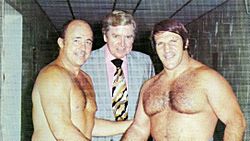
Vincent J. McMahon and Toots Mondt became very successful. In 1963, they had a disagreement with the NWA about how the NWA World Heavyweight Championship was being handled. Because of this, Mondt and McMahon left the NWA and started the World Wide Wrestling Federation (WWWF). In April 1963, the WWWF World Heavyweight Championship was created. The first champion, Buddy Rogers, lost the title a month later to Bruno Sammartino. Sammartino became a huge star for the company.
In 1971, the WWWF quietly rejoined the NWA. In 1979, the WWWF changed its name to the World Wrestling Federation (WWF).
Titan Sports Takes Over (1980–1999)
A New Beginning (1980–1982)
Vincent K. McMahon, son of Vincent J. McMahon, and his wife Linda, started Titan Sports, Inc., in 1980. They wanted to make the WWF a big name in wrestling.
The Wrestling Boom (1982–1992)
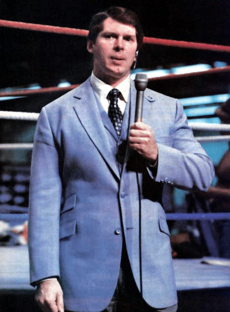
The younger McMahon bought the wrestling company from his father in 1982. He wanted to make the WWF the top wrestling company in the country, and eventually, the world. He started expanding the business, which changed wrestling forever. He began showing WWF programs on TV all across the United States. This upset other wrestling promoters and changed the way wrestling companies usually operated.
McMahon gained a lot of attention when he hired Hulk Hogan, a popular wrestler who was also known for his role in the movie Rocky III. Other famous wrestlers like Roddy Piper, Jesse Ventura, The Iron Sheik, and André the Giant also joined the WWF.
The WWF took a big risk by touring nationally, which cost a lot of money. The future of McMahon's plan depended on the success of his new idea: WrestleMania. WrestleMania was a huge success. It was promoted as the "Super Bowl of professional wrestling." McMahon invited celebrities like Mr. T, Muhammad Ali, and Cyndi Lauper to be part of the event. This mix of popular culture and wrestling was called the Rock 'n' Wrestling Connection.
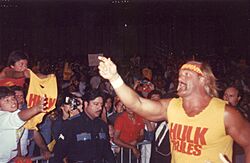
The WWF grew a lot thanks to McMahon and its hero, Hulk Hogan. In 1985, Saturday Night's Main Event started airing on NBC. This was the first time professional wrestling was shown on network TV since the 1950s. The "Wrestling Boom" of the 1980s reached its peak with WrestleMania III in 1987. This event set an attendance record of 93,173 people for the WWF, which lasted for 29 years.
The New Generation (1992–1997)

During this time, the WWF focused on promoting younger wrestlers. This group was called "The New Generation." It included stars like Bret Hart, Shawn Michaels, Diesel, Razor Ramon, and The Undertaker.
In January 1993, the WWF launched its main TV show, Monday Night Raw. In September 1995, a rival company, World Championship Wrestling (WCW), started its own show called Monday Nitro at the same time. This began the "Monday Night War," where the two shows competed for TV ratings. Nitro became very popular for a while, especially with the introduction of the New World Order (nWo) group, which included former WWF stars.
The Attitude Era Begins (1997–1999)
As the "Monday Night War" continued, the WWF changed its style to be more exciting and edgy. This period became known as the Attitude Era. It was led by Shane McMahon (Vince McMahon's son) and head writer Vince Russo.
Before this, the WWF started hiring wrestlers from WCW, including Stone Cold Steve Austin, Mankind, and Vader. Stone Cold Steve Austin became a new top star for the company.
On April 29, 1999, the WWF launched another TV show called SmackDown! on the UPN network. This show became a weekly series on August 26, 1999.
World Wrestling Federation Entertainment, Inc. (1999–2002)
Going Public (1999)
In the summer of 1999, Titan Sports, Inc. changed its name to World Wrestling Federation Entertainment, Inc. On October 19, 1999, the company became publicly traded on the New York Stock Exchange (NYSE) under the symbol WWE. This meant people could buy shares of the company.
End of an Era (1999–2002)
By late 1999, the Attitude Era helped the WWF win the "Monday Night War." In March 2001, McMahon bought the rights to WCW's trademarks, video library, and other properties. This made WWF the largest wrestling company in North America and the world. WWF also bought the assets of Extreme Championship Wrestling (ECW) in 2003, after that company closed.
In 2000, the WWF, with NBC, launched the XFL, a new professional football league. It started in 2001 but closed after only one season.
World Wrestling Entertainment, Inc. (2002–2023)
New Name, New Focus (2002)
On May 6, 2002, the World Wrestling Federation (WWF) changed its name to World Wrestling Entertainment (WWE). This happened after a legal case with the World Wildlife Fund over the "WWF" initials. The company said this change also helped them show their focus on entertainment.
Splitting the Brands (2002–2011)
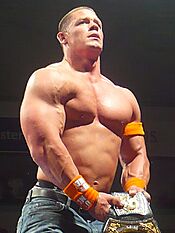
In March 2002, WWE decided to split its wrestlers into two separate groups, or "brands," for their main shows, Raw and SmackDown!. This was called the "brand extension." This allowed more wrestlers to be featured.
WWE also brought back ECW as a third brand in 2006. Two years later, WWE made its shows more family-friendly and received a TV-PG rating. The ECW show ended in 2010 and was replaced by NXT. Many new and young wrestlers like John Cena, Randy Orton, Brock Lesnar, and Batista became famous during this time.
On April 7, 2011, WWE announced it would only use the initials WWE, reflecting its growth into a global entertainment company beyond just wrestling. However, the company's legal name remained World Wrestling Entertainment, Inc.
Coming Back Together (2011–2016)
Starting in August 2011, Raw (called Raw Supershow for a while) featured wrestlers from both Raw and SmackDown. This meant the "brand split" ended, and all WWE shows and live events featured the full roster of wrestlers until July 2016.
In 2013, the company built the WWE Performance Center in Orlando, Florida. This is a training facility for future WWE wrestlers. It's also the home base for WWE's NXT brand, which helps wrestlers develop their skills.
On February 24, 2014, WWE launched WWE Network, a streaming service. It offered old WWE shows, all pay-per-view events, and new original programs. It quickly became very popular.
The Second Brand Split (2016–2020)
On May 25, 2016, WWE brought back the brand split, calling it the "New Era." Raw and SmackDown each got their own unique wrestlers, announcers, championships, and ring designs. A draft was held to decide which wrestlers would go to which show. SmackDown also moved to Tuesday nights and started airing live.
Because of the brand split, a new World Championship called the WWE Universal Championship was created in August 2016.
WWE also launched a show for smaller, faster wrestlers (under 205 lbs.) called WWE 205 Live in November 2016. In December 2016, WWE created the WWE United Kingdom Championship and later launched a UK-based brand called NXT UK in June 2018.
In September 2019, NXT began airing weekly live shows on the USA Network. WWE started calling NXT its "third brand." However, in 2021, NXT moved to Tuesday nights and later returned to its original role as a training brand for Raw and SmackDown, under the name "NXT 2.0."
During the Pandemic and Return to Live Shows (2020–2022)
In March 2020, the COVID-19 pandemic affected WWE. They started filming shows at the Performance Center without fans and with only essential staff. WrestleMania 36 was moved and held without fans.
Live shows returned on April 13, 2020. Florida's Governor said WWE was important to the state's economy, allowing them to continue.
In August 2020, WWE moved its shows to the Amway Center in Orlando, using a virtual fan experience called WWE ThunderDome. This allowed fans to appear on LED screens. Roman Reigns began his long-lasting world title reign during this time. The ThunderDome later moved to other locations. In October 2020, NXT shows moved to the Performance Center with a small number of live fans, called the Capitol Wrestling Center. In May 2021, WWE brought back full crowds for its shows.
WrestleMania 37 in April 2021 was the first WWE event during the pandemic to have fans in attendance, though with limited capacity. Also, in March 2021, the WWE Network in the United States became part of the Peacock streaming service.
In February 2022, the 205 Live show was replaced by a new NXT show called Level Up.
Changes in Leadership (2022–2023)

On June 17, 2022, Vince McMahon stepped down as chairman and CEO of WWE. His daughter, Stephanie McMahon, became the interim chairwoman. On July 22, 2022, Vince McMahon officially retired. Stephanie McMahon was then named chairwoman, and she and Nick Khan became co-CEOs. Triple H took over as the head of creative content. This was a big change for WWE.
On January 10, 2023, Stephanie McMahon resigned. Vince McMahon returned as executive Chairman, and Nick Khan became the sole CEO.
WWE Joins Endeavor (2023)
On April 3, 2023, WWE and Endeavor (the company that owns UFC) announced a deal. WWE would merge with UFC to form a new company called TKO. Endeavor would own 51% of TKO, and WWE's shareholders would own 49%. This was the first time the McMahon family did not have majority control of WWE. Vince McMahon was named executive chairman of the new company, and Endeavor CEO Ari Emanuel became CEO of TKO. Paul Levesque remained in charge of WWE's creative content.
World Wrestling Entertainment, LLC (2023–Present)
TKO Group Holdings is Formed (2023–Present)
The merger between WWE and UFC to form TKO Group Holdings (TKO) was completed on September 12, 2023. WWE and UFC continue to operate as separate parts of TKO. The first WWE show under the new Endeavor ownership was NXT on September 12, 2023. Popular wrestler CM Punk returned to WWE in late 2023.
On January 23, 2024, Dwayne Johnson, also known as "The Rock," joined the TKO Group Holdings board of directors. Three days later, on January 26, Vince McMahon resigned again. Ari Emanuel then gained more control as the new Chairman of TKO.
On April 1, 2024, Triple H said that WWE had entered "another era." At WrestleMania XL, WWE debuted a new intro. Triple H welcomed fans to "a new time, a new era," and Stephanie McMahon called it the "Paul Levesque era." On April 7, Cody Rhodes won the Undisputed WWE Universal Championship at WrestleMania XL.
On January 23, 2024, WWE announced that WWE Raw will move to the Netflix streaming service in January 2025. Netflix will also be the exclusive home for all WWE content outside the U.S., including documentaries, original series, SmackDown, NXT, and major live events like WrestleMania.
In 2024, WWE started working more closely with Total Nonstop Action Wrestling (TNA). Wrestlers from both companies began appearing on each other's shows. A multi-year partnership between TNA and WWE was officially announced on January 16, 2025. WWE also formed partnerships with Pro Wrestling Noah and Dream Star Fighting Marigold. On April 19, 2025, WWE announced it had bought Lucha Libre AAA Worldwide, a Mexican wrestling company, as part of its global growth.
Championships and Awards
WWE has many championships that wrestlers compete for. These titles represent who is the best in different categories.
List of current champions in WWE
Past Championships
Over the years, WWE has also had championships that are no longer used.
Wrestler Contracts
Most WWE wrestlers sign special contracts. This means they can only perform for WWE shows and events. They usually can't work for other wrestling companies unless WWE makes a special agreement. WWE keeps details about wrestler salaries and contracts private.
WWE considers its wrestlers as independent contractors, not employees. This means wrestlers don't get some benefits that regular employees would. However, WWE has a program called "next in line agreements" for college athletes, which is approved by the NCAA.
WWE Network and TV Shows
On February 24, 2014, WWE launched WWE Network, a streaming service where fans can watch wrestling shows online. It includes old WWE shows, all major live events, and new original programs. It quickly became very popular, reaching 1,000,000 subscribers in less than a year.
WWE has deals with many TV networks around the world to show its programs. For example, in May 2014, WWE and NBCUniversal agreed to keep Raw and SmackDown on the USA Network and Syfy.
Starting March 18, 2021, the WWE Network in the United States became part of the Peacock streaming service. This change did not affect the service outside the United States.
On September 9, 2022, WWE made a new deal with The Foxtel Group in Australia. This made Foxtel the only place to watch WWE in Australia, including all major live events and original shows.
As announced on January 23, 2024, Netflix will exclusively show WWE Raw starting in January 2025 in the United States, Latin America, Canada, and the United Kingdom. Netflix will also be the exclusive home for all WWE content outside the U.S., including documentaries, original series, SmackDown, NXT, and major live events.
WWE's Main Shows
| Program | When it Started | Where to Watch | Notes |
|---|---|---|---|
| WWE Raw | January 11, 1993–present | Netflix | One of WWE's two main shows, airing on Mondays. |
| WWE SmackDown | April 29, 1999–present | USA | One of WWE's two main shows, airing on Fridays. |
| WWE NXT | February 23, 2010–present | The CW | A show for developing wrestlers, airing on Tuesdays. |
| Saturday Night's Main Event | December 14, 2024–present | NBC Peacock |
Special TV shows that air a few times a year on Saturdays. |
| WWE Speed | April 13, 2024–present | X | Streams on X (formerly Twitter). |
| Premium Live Events | March 31, 1985–present | Peacock | Big events that happen about once a month. They used to be called Pay-per-views. |
Special Words in WWE
WWE uses some special terms to describe its world:
- The wrestling business is called "sports entertainment."
- Fans of the main shows are called the "WWE Universe."
- Fans of NXT shows are called the "NXT Universe."
- Wrestlers on the main shows are "WWE Superstars."
- Wrestlers in NXT are "NXT Superstars."
- Retired wrestlers are "WWE Legends."
- Wrestlers who are honored in the WWE Hall of Fame are called "Hall of Famers."
Beyond Wrestling: Other WWE Ventures
Other Companies WWE Owns
Active Companies
- TSI Realty Co. (1997–present): A company that handles real estate.
- WWE Books (2002–present): Publishes books about WWE, like biographies of wrestlers and behind-the-scenes guides.
- WCW Inc. (2001–present): A company created after WWE bought the rights to World Championship Wrestling's videos and ideas.
- WWE Legacy Department (2001–present): A collection of wrestling videos and copyrights.
- WWE Studios (2002–present): Makes movies, TV shows, and digital content.
- WWE Music Group (2006–present): Releases music, especially wrestlers' entrance themes.
- WWE Jet Services, Inc. (2013–present): Manages the company's private jets.
- WWE Performance Center (2013–present): The main training center for future WWE wrestlers.
- WWE Shop (2015–present): The official website to buy WWE clothes and merchandise.
- WWE Podcast Network (2019–present): A network where several WWE wrestlers host their own podcasts.
- Lucha Libre AAA Worldwide (2025–present): A Mexican wrestling company that WWE acquired.
Companies That Are No Longer Active
- World Bodybuilding Federation (1990–1992): A company that promoted professional bodybuilding.
- Radio WWF (1993): A radio station that covered WWF stories.
- Wrestle Vessel (1996–1999): WWE-themed cruise ship experiences.
- WWE Home Video (1997–2023): Distributed WWE shows and compilations on VHS, DVD, and Blu-ray. These were stopped in late 2023.
- XFL (2000–2001): A professional football league that was partly owned by WWF.
- The World Entertainment (1999–2003): A restaurant, nightclub, and shop in New York City.
- WWE Niagara Falls (2002–2011): A retail store and amusement place in Canada.
- WWE Classics on Demand (2004–2014): A TV service that showed old wrestling footage.
- WWE Kids (2008–2014): A website and comic series for younger fans.
- WWE Universe (2008–2011): A social media website for fans.
- WWE Magazine (1983–2014): WWE's official magazine.
WWE's Investments
WWE has also invested in other companies:
- Tout: A short video social media service (2012-2014).
- Marvel Experience: An interactive live event with Marvel characters (2013).
- Phunware: A company that creates mobile apps (2014).
- FloSports: A sports streaming service (2016, 2019).
- Avid Technology: A company that makes audio and video technology (2016).
- Drone Racing League: A league for drone races (2017).
- Cloud9: An esports organization (2017).
- DraftKings: WWE's fantasy sports partner.
- Rad: A streaming platform (2021).
- Jomboy Media: A multimedia company that produces a baseball show (2022).
- Premier Lacrosse League: A professional lacrosse league (2022).
Charity Work
WWE is involved in many charity efforts:
- Make-A-Wish Foundation: WWE has partnered with Make-A-Wish for over 40 years. John Cena has granted more wishes than any other celebrity.
- United Service Organizations (USO): WWE partners with the USO to host shows for military members around the world.
- Be A S.T.A.R. (Show Tolerance and Respect): In 2011, WWE launched this anti-bullying campaign for children.
- Susan G. Komen for the Cure: Since 2012, WWE has partnered to raise awareness for breast cancer in October.
- Hire Heroes USA: Since 2012, WWE has helped veterans find jobs.
- Connor's Cure: Started in 2014 by Triple H and Stephanie McMahon, this charity helps children with brain and spinal cord tumors. In September, WWE uses a gold color scheme to raise awareness for pediatric cancer.
- Special Olympics: WWE has partnered with Special Olympics since 2014.
- Boys & Girls Clubs of America: WWE has partnered with this organization since 2016.
- Girl Up: In 2018, WWE and the United Nations Foundation's Girl Up created "Sports for a Purpose" to encourage girls' participation in sports.
- Leukemia & Lymphoma Society: Since 2019, WWE has partnered to support leukemia research.
- National Medal of Honor Museum Foundation: Since 2021, WWE has partnered to honor Medal of Honor recipients.
Working with Tapout
In March 2015, WWE teamed up with Authentic Brands Group to relaunch Tapout. Tapout, once a major MMA clothing brand, became a general "lifestyle fitness" brand. WWE owns 50% of the brand and promotes it across its platforms.
Working with Other Wrestling Companies
WWE has sometimes worked with other wrestling companies:
- In the 1970s, 80s, and early 90s, WWE worked with Japanese companies like New Japan Pro-Wrestling (NJPW) and Mexican companies like Universal Wrestling Association (UWA).
- From 1992–1996, WWE had talent exchange agreements with independent companies like Smokey Mountain Wrestling (SMW) in the U.S. and Super World of Sports (SWS) in Japan.
- In 1997, WWE worked with Mexico's AAA promotion, bringing some of their wrestlers to the Royal Rumble event.
- From 1997 to 1998, WWE partnered with the National Wrestling Alliance (NWA), showing NWA matches on its programs.
- In 2015, WWE partnered with Evolve, a U.S. independent promotion, to scout new talent for NXT. WWE bought Evolve in 2020.
- In 2016, WWE partnered with England's Progress Wrestling. Some Progress wrestlers appeared in WWE tournaments. Progress shows also aired on the WWE Network until January 2023.
- In 2017, WWE partnered with Scotland's Insane Championship Wrestling (ICW). Some ICW talent appeared in WWE events, and ICW shows aired on the WWE Network until January 2023.
- In 2018, WWE partnered with Germany's Westside Xtreme Wrestling (wXw). wXw shows aired on the WWE Network until May 2024.
- In February 2023, WWE's NXT brand partnered with Reality of Wrestling (ROW), an independent promotion owned by Booker T.
- In December 2023, WWE partnered with All Japan Pro Wrestling (AJPW). This partnership ended in late 2024.
- Throughout 2024, WWE partnered with Dream Star Fighting Marigold (Marigold), Pro Wrestling Noah (NOAH), and Game Changer Wrestling (GCW).
- In October 2024, WWE launched the WWE ID system to help train independent wrestlers.
- In January 2025, WWE announced a multi-year partnership with Total Nonstop Action Wrestling (TNA), allowing wrestlers from both companies to appear on each other's shows.
- Historically, WWE has also had arrangements with other independent companies in the U.S. and Puerto Rico that served as training grounds for new talent.
Wrestler Health and Safety Program
WWE has a program to ensure the health and safety of its wrestlers. This program, called the Talent Wellness Program, started in February 2006. It includes testing for certain substances and annual heart health checks. The program applies to all wrestlers who regularly perform in the ring.
In August 2007, ten wrestlers were suspended for breaking the rules of the Wellness Policy. On September 13, 2010, WWE updated its list of banned substances to include muscle relaxers.
|


